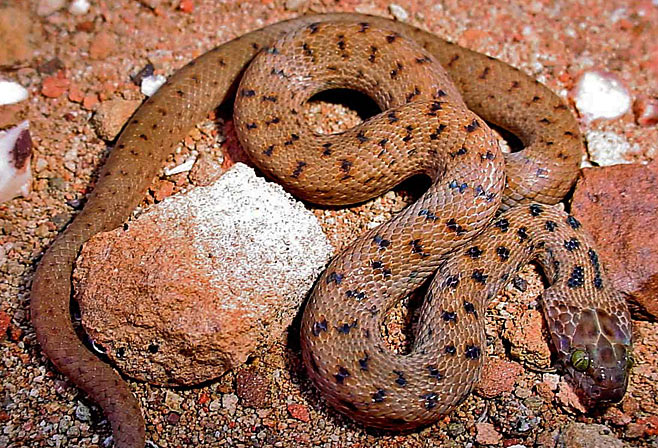|
Lamprophis guttatus (Spotted rock snake, Spotted house
snake)
Gevlekte rotsslang [Afrikaans]
Life >
Eukaryotes
>
Opisthokonta >
Metazoa
(animals) > Bilateria > Deuterostomia >
Chordata >
Craniata > Vertebrata (vertebrates) > Gnathostomata (jawed vertebrates) >
Teleostomi (teleost fish) > Osteichthyes (bony fish) > Class:
Sarcopterygii (lobe-finned fish) > Stegocephalia (terrestrial vertebrates) >
Tetrapoda
(four-legged vertebrates) > Reptiliomorpha > Amniota >
Reptilia (reptiles) >
Romeriida > Diapsida > Lepidosauromorpha > Lepidosauria >
Squamata > Serpentes
(snakes) > Family: Colubridae > Subfamily:
Boodontinae > Genus:
Lamprophis
 |
|
Lamprophis guttatus (Spotted rock snake, Spotted house
snake), Western Cape. [E.R. le Roux ©, from
SARCA Virtual Museum] |
Identification
The Spotted rock snake can be identified by its dark brown
spots which form a zigzag pattern, its preference for rock crags and a strictly
nocturnal lifestyle. It grows to an average length of 50 cm but may reach 60 cm.
Distribution and habitat
Found along the entire coast line of South
Africa and the eastern half of the interior. It is found in nearly all habitats
but most commonly in fynbos and karoo scrub.
Food
This snake feeds on lizards (particularly geckos and
skinks) and
rodents
(e.g.
rats and mice).
Predators, parasites and disease
This snake species is eaten by other snakes.
Reproduction
Oviparous (egg-laying), lays between 3 and 6 eggs in
summer.
Longevity
Has been known to live for 20 years in
captivity
Medical importance
Non-venomous and not dangerous to man and not likely to
bite.
Links
References
-
Broadley, D.G. 1983. FitzSimons' Snakes of Southern
Africa. Delta Books, Johannesburg.
-
Marais, J. 2004. A Complete Guide to Snakes of
Southern Africa. Struik Publishing, Cape Town.
|
